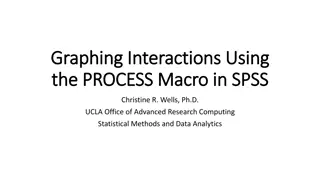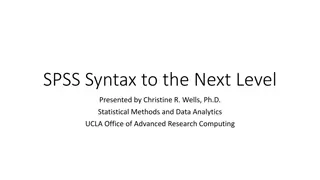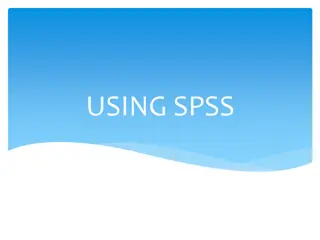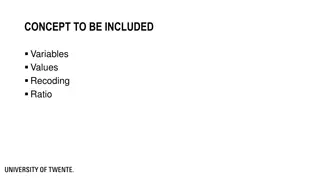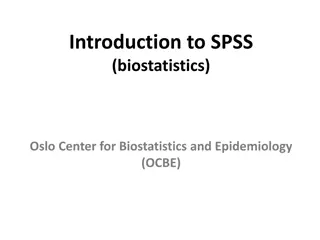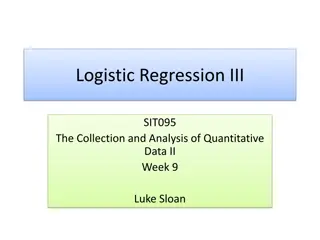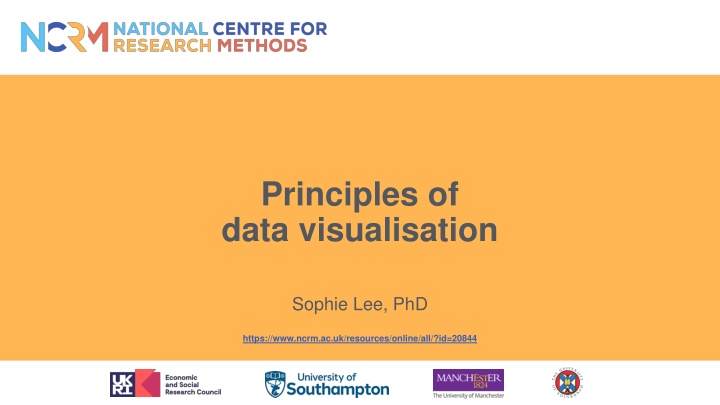
Introduction to SPSS: Research Computing Services Tutorial
Learn about SPSS through Research Computing Services tutorial at BU. Explore SPSS for desktop, define variables, input and analyze data, and more. Discover SPSS availability, versions, and data vs. variable view distinctions. Gain insights into questionnaire sampling in SPSS for research purposes.
Download Presentation

Please find below an Image/Link to download the presentation.
The content on the website is provided AS IS for your information and personal use only. It may not be sold, licensed, or shared on other websites without obtaining consent from the author. If you encounter any issues during the download, it is possible that the publisher has removed the file from their server.
You are allowed to download the files provided on this website for personal or commercial use, subject to the condition that they are used lawfully. All files are the property of their respective owners.
The content on the website is provided AS IS for your information and personal use only. It may not be sold, licensed, or shared on other websites without obtaining consent from the author.
E N D
Presentation Transcript
Principles of data visualisation Sophie Lee, PhD https://www.ncrm.ac.uk/resources/online/all/?id=20844
Why is data visualisation so important? Visualisation is a part of each point in an analysis journey: Exploring the data
Why is data visualisation so important? Visualisation is a part of each point in an analysis journey: Exploring the data Checking assumptions for parametric tests and models
Why is data visualisation so important? Visualisation is a part of each point in an analysis journey: Exploring the data Checking assumptions for parametric tests and models Generating hypotheses about trends and relationships in the data
Why is data visualisation so important? Visualisation is a part of each point in an analysis journey: Exploring the data Checking assumptions for parametric tests and models Generating hypotheses about trends and relationships in the data Convey important results and messages in a clear, concise way
What makes a good data visualisation? Graphical excellence is the well-designed presentation of interesting data - a matter of substance, statistics and design - Edward Tufte, The Visual Display of Quantitative information How do we find the correct balance between these elements?
Four key principles for good data visualisation 1. Show the data! 2. Choose an appropriate design 3. Ensure data integrity 4. Make the visualisation accessible
Show the data Maximise the information in the smallest amount of space
Show the data Maximise the information in the smallest amount of space Adding too much data can lead to confusion
Show the data Maximise the information in the smallest amount of space Adding too much data can lead to confusion Choose the most appropriate data to achieve the visualisation s goal!
Visualisation design Choice of visualisation should be decided by the context, the audience, and the goal of the graphic Choice of visualisation will also depend on the type and number of variable we wish to show Check out https://www.data-to-viz.com/ for visualisation choices based on variable type
Visualisation design Reduce the amount of chartjunk: - Unnecessary colours - Overbearing gridlines - Distracting patterns BUT do not sacrifice context for minimalism
Data integrity Do not distort the data in any way! The visual representation of data is consistent with the numerical representation Be aware of how perceptions may alter the interpretation of a visualisation
Make the visualisation accessible
Accessibility All aspects of a visualisation must be interpretable and accessible Ensure design choices are inclusive
Accessibility: text Make text large enough to be legible - At least 12pt when printed, 36pt for presentations Choose an inclusive font that is accessible for visual impairment and learning difficulties - Arial and Verdana are often cited as accessible fonts
Inclusive colours Choose colour palettes where each colour is distinct, including to those with colour-vision deficiencies - Check palettes using a colour-blindness simulator
From Fundamentals of Data Visualization, Claus O. Wilke
Inclusive colours Choose colour palettes where each colour is distinct, including to those with colour-vision deficiencies - Check palettes using a colour-blindness simulator - Avoid cyclical palettes like rainbow colours
Inclusive colours Choose colour palettes where each colour is distinct, including to those with colour-vision deficiencies - Check palettes using a colour-blindness simulator - Avoid cyclical palettes like rainbow colours Ensure colour choices make sense, e.g. blue for cold, red for hot and not the other way around Avoid stereotypes such as pink for female and blue for male
Reproducibility Where appropriate, ensure data and code used to create visualisations is available and open Consider using free repositories, e.g. Github, to host this


